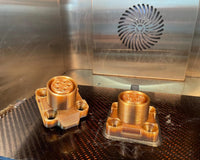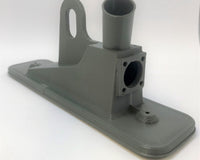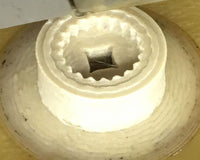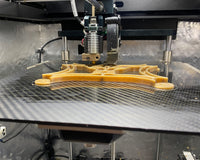Facilan™ C8 is a new kind of 3D printing material. Developed to be a functional 3D printing material for manufacturing, C8 has been optimized for high throughput, high-reliability applications in 3D printing. Designed and developed for manufacturing applications Facilan™ C8 is the first of a family of Facilan™ materials that will cater to enterprise, engineering and industrial users of 3D printing.
Facilan™ C8:
- has higher impact strength than ABS.
- has higher tensile strength than ABS.
- is tougher than PLA.
- is compostable at home.
- has a luxuriously soft touch feel.
- has the best layer adhesion properties of any FDM material.
- has the best surface quality of any FDM material.
- On most 3D printers there should be no visible layers in products 3D printed with Facilan™ C8. Products should be smooth with an even matte surface.
In short, C8 is a compostable, easy to print, high strength, soft touch 3D printing material with the smoothest surfaces of any FDM 3D printing material. C8 has been designed and developed to let companies manufacture 3D printed products with it. High-grade prototyping and demanding applications for makers also could be uses for the material, but what we hope that you’ll use it for is to manufacture.

How we got here.
We’re a small but growing company that manufactures materials for over 40 Universities worldwide researching bioprinting, aviation, soft robotics or orthopedics. Drug-loaded implants, artificial trachea, ‘smart materials,' scaffolds, and end-use parts in industry are what we make our materials for. Our biggest customers are companies making commercial aircraft, precision machinery, race cars, medical devices and consumer electronics.
It is for these customers that we have developed a material that will outperform existing materials. More consumer-friendly, C8 will let people sell 3D printed products without visible layers. FDM as a technology already makes very dimensionally accurate tough parts. The drawback of the technology has always been in the way these parts looks. C8 changes this by making 3D printed parts completely smooth for the first time. They will, in the real world, look much better than the parts made so far. Higher strength means that the resulting parts will also be able to perform in the real world. C8 is a real-world material made for end-use applications in products. It is meant to make it more likely that desktop FDM printers will be used for manufacturing. We believe that we are collectively on the cusp of seeing desktop machines being used to manufacture at scale. We wish to engender this movement by developing materials to make this happen sooner.

Our unique extrusion technology lets us produce high tolerance filament with superior interlayer bonding. We have a 100% roundness on our filament and less than +/- 0.05 mm tolerance on filament diameter across the entire length of our filament (not measured just a few times). We know that we can make good filament and develop new innovative filaments. It took Perstorp working with us, however, to be able to make a truly breakthrough filament.
Perstorp & 3D4Makers
Perstorp is an innovative Swedish specialty Chemicals company. Over a 130 years old, with 1500 employees and $1,3 billion in revenue. Perstorp has been at the forefront of developing biofuels, coatings, and adhesives for over a generation. Perstorp materials probably surround you right now, making your car go further, your desk last longer or turning your carrier bag into a compostable one instead of landfill. Perstorp develops specialty chemicals and value-added chemistry. Essentially they look at the world of polymers, coatings, adhesives, and biofuels and imagine how it could be made better. Processes make the things that make the things that surround you. Perstorp develops the materials that improve these processes and the products that come out of them.
Unparalleled Research
Many polymer and chemical companies have visited the 3D4Makers offices over the past years. Enticed by rumors of our innovative production technology and spurned on by our space and aviation clients people do become curious. Were a small startup, however, consisting of 8 people. Most days half of us are crawling all over a new extrusion line to improve it, wrench in hand. Perstorp was the first company that really saw the potential of our technology. Perstorp alone understood that a company that was the only one making engineering filaments for manufacturing using FDM 3D printing posed such potential. Over the past year, they’ve worked with us to develop Facilan™ C8. It is their deep and unparalleled knowledge of the chemistry and polymers that let C8 become what it is. Their rigorous testing and extensive expertizes across many areas have let C8 become a unique thing. C8 is a material that in 50 days or so can become absorbed into the earth and yet is stronger than the ABS’s and PLA’s on offer nowadays. Both greener and more functional at the same time. It is their experience and breadth of ambition that propelled us both to create such an innovative material. We’re grateful for working with a company that is willing to leverage so much knowledge and effort towards improving 3D printing through true innovation in materials.
Fifth Generation Material
Initially, in the 90’s first generation 3D printing materials consisted of whatever would work on the newly developed 3D printers. Waxes and simple materials that would let this technology develop a tangible object. Second generation materials were meant to make higher quality prototypes and were intended to look good above all (PLA, ABS). Higher heat deflection and strength materials optimized for 3D printing through fillers and additives comprised of third generation materials (Ngen and other PETG’s, PA’s, ABS M30, the so-called PLA+’s). Fourth generation materials were Engineering Plastics such as PEI and PPSU that brought unheard of mechanical properties and head deflection to 3D Printing. Fifth generation 3D printing materials have been designed from the ground up to be 3D Printing materials. Not just repurposing a general polymer such as PLA and dressing it up with lots of additives to make it work. These materials are also not the same old PLA, but with a new name. These are the first functional 3D printing materials designed for the manufacturing of end-use parts. Optimized for high throughput applications and with consumer-friendly qualities, Facilan™ C8 is not the past or present of 3D printing, but its future. Polymers made from start to finish to perform in a 3D printed world.
Feedback
We hope that you will help us test and review Facilan™ C8. Your feedback is instrumental in helping us develop the next line of Facilan™ materials. We've sent the material to a select number of 3D printing and Additive Manufacturing experts for review. Their initial feedback is positive. They say things such as, "by far the best 3DP material I've ever used" and "I'm getting close to an injection molding finish on parts." We're curious as to what you will tell us.
Would you like to try Facilan™ C8? Purchase a spool here.







2 comments
Anonymous
For car parts, we would recommend other materials such as PPSU, PEI or ASA or ABS.
gr5
Working temperature? Can I use parts printed with this material in my car for example as a cell phone holder? Or will it slump when it hits ~125F (~52C) like PLA does?